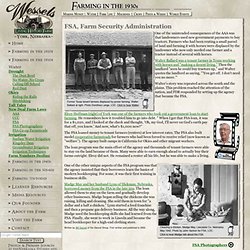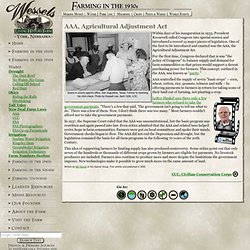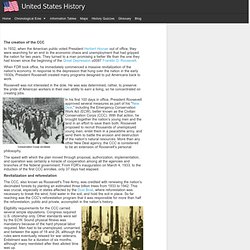Zoom
Trash

The FSA, Farm Security Administration Helps Tenant Farmers. FSA, Farm Security Administration One of the unintended consequences of the AAA was that landowners used new government payments to buy tractors.

Farmers who had been renting a small parcel of land and farming it with horses were displaced by the landowner who now only needed one farmer and a tractor instead of several with horses. Walter's story was repeated across the south and the plains. This problem reached the attention of the nation, and FDR responded by setting up the agency that became the FSA. The FSA loaned money to tenant farmers (renters) at low interest rates. The loan program was the main effort of the agency and thousands of tenant farmers were able to stay on the land because of them. One of the other unique aspects of the FSA program was that the agency insisted that their borrowers learn the basics of modern bookkeeping. AAA, the Agricultural Adjustment Act & Administration. AAA, Agricultural Adjustment Act Within days of his inauguration in 1933, President Roosevelt called Congress into special session and introduced a record 15 major pieces of legislation.

One of the first to be introduced and enacted was the AAA, the Agricultural Adjustment Act. For the first time, Congress declared that is was "the policy of Congress" to balance supply and demand for farm commodities so that prices would support a decent purchasing power for farmers. This concept, outlined in the AAA, was known as "parity.
" AAA controlled the supply of seven "basic crops" – corn, wheat, cotton, rice, peanuts, tobacco and milk – by offering payments to farmers in return for taking some of their land out of farming, not planting a crop. In 1937, the Supreme Court ruled that the AAA was unconstitutional, but the basic program was rewritten and again passed into law. This idea of supporting farmers by limiting supply has also produced controversy. New Deal/WPA History. {*style:<b>Public Works of Art Project (PWAP) - established under the Treasury Department with funds transferred from the CWA - December 1933 - June 1934 National Director: Edward Bruce Goal: To furnish work for unemployed artists in the decoration of public buildings and parks. {*style:<b>The Section (Treasury Department) October 13, 1934 - June 30, 1943 This program changed names several times during its existence.
The Treasury Dept. The Treasury Department Section of Fine Arts (1938-1939) The Section of Fine Arts (transferred to the new Federal Works Agency) (1939-1943) Goal: To decorate new federal buildings with work of the highest quality. <i>Article about the Treasury Department's Section of Fine Art </i></b>*} {*style:<b>Treasury Relief Art Project (TRAP) - funds from the Works Progress Administration/Emergency Relief granted to the Treasury Department- July 1935 - June 1939 National Director: Olin Dows/Cecil Jones {*style:<b>Works Progress Administration/Federal Art Project (WPA/FAP) Civilian Conservation Corps (CCC) The creation of the CCC In 1932, when the American public voted President Herbert Hoover out of office, they were searching for an end to the economic chaos and unemployment that had gripped the nation for two years.

They turned to a man promising a better life than the one they had known since the beginning of the Great Depression u0097 Franklin D. Roosevelt. When FDR took office, he immediately commenced a massive revitalization of the nation's economy. In response to the depression that hung over the nation in the early 1930s, President Roosevelt created many programs designed to put Americans back to work. Roosevelt was not interested in the dole. In his first 100 days in office, President Roosevelt approved several measures as part of his "New Deal," including the Emergency Conservation Work Act (ECW), better known as the Civilian Conservation Corps (CCC). Revitalization and reforestation Eligibility requirements for the CCC carried several simple stipulations. CCC projects included: